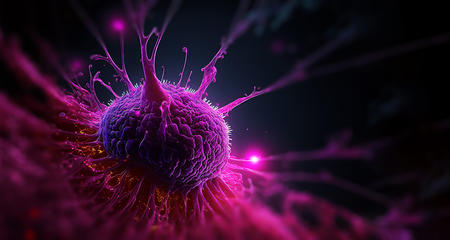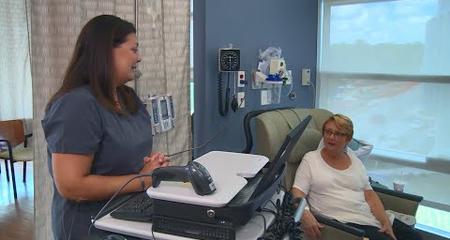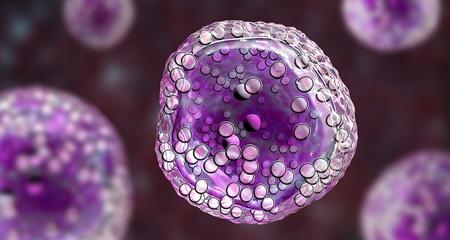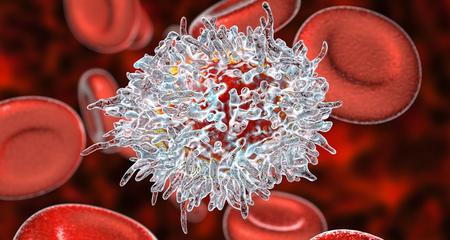Lymphomas are cancers that arise in a type of white blood cell known as a lymphocyte. Lymphomas often produce tumor masses in lymph nodes and other part of the body. Lymphoma cells can also suppress the production of healthy blood cells, leading to a range of symptoms. Every year, about 82,000 people in the U.S. are diagnosed with a form of lymphoma.
Non-Hodgkin Lymphoma
New CAR T-Cell Therapy
The Clinical Cancer Center at Froedtert Hospital is the first in the world to offer a unique form of CAR T-cell therapy to treat certain non-Hodgkin lymphomas (B-cell).Non-Hodgkin lymphoma (NHL) is a collection of more than 50 different cancers that affect the lymph nodes and/or the immune system. NHL accounts for nearly 90 percent of all cases of lymphoma. The risk of developing NHL generally increases with age.
NHL can cause a variety of symptoms ranging from mild to severe, or the disease may be discovered incidentally during evaluation for another problem. Typical symptoms include lymph node swelling in the neck, armpit or groin. NHL that starts outside the lymph nodes can cause bone pain, chest pain, fever, drenching night sweats, fatigue and weight loss. Some cases of NHL can be traced to immune suppression, certain medications, or certain viruses or bacteria.
NHLs are classified as either indolent (slow-growing) or aggressive. The stage of the disease is determined by how extensively the cancer has spread to lymph nodes and other organs. Because there are so many types of NHL, a proper diagnosis is essential to identifying the appropriate treatment.
Treatment strategies for NHL vary widely depending on the type and stage of the disease and the patient’s age and health. In some cases treatment may not even be necessary. Treatments range from mild immune therapy, to immunotherapy, to chemotherapy, to radiation therapy, to newer targeted drug therapies. Stem cell transplant is used in some cases.
Hodgkin Lymphoma
Hodgkin lymphoma is a cancer of the lymph nodes. Hodgkin lymphoma was previously known as Hodgkin’s Disease. This cancer mainly affects people between the ages of 15 and 40, but it can also affect older adults. Most patients have few symptoms at diagnosis other than neck swelling due to lymph node enlargement. In other cases there may be severe symptoms such as fevers, drenching night sweats, weight loss or itching.
The cause of Hodgkin lymphoma is not clear, but it is more common in certain parts of the world. Some cases may be caused in part by prior exposure to Epstein-Barr virus (EBV), the virus that causes infectious mononucleosis. There are a variety of sub-types of Hodgkin lymphoma.
Treatment for early-stage Hodgkin lymphoma usually consists of chemotherapy and radiation therapy. Chemotherapy is a combination of several different drugs. For advanced cases, chemotherapy alone is used. For patients who do not achieve remission or who relapse after first-line therapy, a stem cell transplant is often performed. Several promising new drugs and transplant techniques are available for more difficult cases. The overall treatment success rate for Hodgkin lymphoma is quite high, with 80 percent or more of patients being cured. Because of this high success rate, it is important to consider potential side effects (including some complications that can arise years later) when planning treatment.
Cutaneous T-Cell Lymphoma
Cutaneous T-cell lymphoma (CTCL) is a subtype of non-Hodgkin lymphoma that affects the skin. Patients are usually diagnosed after having a rash, but other symptoms such as itching or lumps in the skin can occur as well. In many cases, only the skin is involved and the disease remains confined to the skin for many years. In other cases, CTCL may spread into the lymph nodes or other parts of the body. Diagnosis can be challenging. Patients may require several skin biopsies before a definitive diagnosis is made.
A multidisciplinary team involves collaboration among dermatologists, radiation oncologists and hematologist/oncologists who specialize in CTCL. These specialists have developed innovative treatment approaches such as photopheresis and electron beam radiation. Other treatment options include topical therapy, light or UV treatments, drugs taken orally, and in some cases chemotherapy. In severe cases, a stem cell transplant may be considered.
Lymphoma Clinical Trials
Clinical trials give many patients access to innovative drugs and treatment approaches. Search our list of clinical trials for lymphoma studies.
Virtual Visits Are Available
Safe and convenient virtual visits by video let you get the care you need via a mobile device, tablet or computer wherever you are. We’ll gather your medical records for you and get our experts’ input so we can offer treatment options without an in-person visit. To schedule a virtual visit, call 1-866-680-0505.
More to Explore





